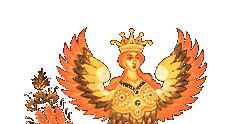The traditional, and festive, bridal garment of the Russian North from the second half of 19th century consisted of a white muslin blouse, a purple satin sarafan (dress without sleeves from Persian - serapa), "half-shugay" (a loose coat with wide sleeves and embroidered with gold treads and a kokoshnik), which is on full displayed at the Nizhniy Novgorod Historical Architectural Museum.
In the 17th century Russian ladies wore formal wide sleeve overcoats called "telogreys" (literally translated into "body warmer"). The boyars and nobles made their formal attire out of fur. During Peter the Great's reforms these transformed into shorter garments that widened towards the ground and were worn unbuttoned, which most often had straps. Its pyramid-like shape follows the silhouette of the saraphan and creates a new proportion for the entire garment. Because of its lightweight design, ability to provide a good high level of warmth, and decorative appeal the "dushegreya", also known as, "shugay" or "half-shugay," became very popular at the time.
A dushegreya is a warm and short women's garment. The name of the garment is Russian and literally means soul warmer. Other nations like France had similar dress attires at the time, which were called "dulyets." Many examples of dushegreyas are displayed in varioius museums throughout Russia. Most prized are the Northern Dushegreys, which followed a bell-bottom stiching and were sewn out of rectangular pieces of either brocade or velvet.
|



